Статьи журнала - Nanotechnologies in Construction: A Scientific Internet-Journal
Все статьи: 409
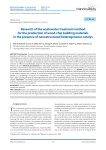
Статья научная
Introduction. Phenols and petroleum products are common wastewater contaminants in many industries. Due to their persistence and toxicity in the natural environment, an efficient waste disposal technology is needed. Ozonation in the presence of heterogeneous catalysts is one of the advanced methods for treating wastewater from these toxicants. Since most catalysts are expensive, they are being sought on the basis of transition metals and their oxides, which have high activity and relatively low cost. In this regard, the Scientific and Educational Center for Innovative Technologies (SECIT) of USPTU carried out work on the search for an effective and affordable catalyst for the deep oxidation of phenol and petroleum products in wastewater under the influence of ozone. Methods and materials. To study catalytic ozonation, we used model waste water containing phenol and oil products at concentrations of 8 and 30 mg/dm3, respectively. Ozonation was carried out in the presence of fresh (1) and spent (2) NiO–MoO3 catalyst deposited in the form of a film on cylindrical Al2O3 granules weighing 0.5 – 2 g. Results. Optimal conditions of ozonation have been found (1), within 10 min of the decomposition process in its presence, COD decreased by 25% compared to the oxidation process with a catalyst (2), and by 40% compared to classical ozonolysis. It was found that the optimal loading of catalyst (1) is 1 g, duration is 35 min, pH = 8.5, temperature – 22 – 30оC, ozone dose – 5 g/dm3. Discussion. At catalyst dosages of less than 1 g/dm3, the low efficiency of removing phenol and hydrocarbons is probably due to a lack of the adsorption surface of the catalyst. Conclusion. The studied method of purification allows to reduce the content of phenol and oil products to the standard indicator of drinking water quality (0.001 and 0.05 mg/dm3, respectively), COD by 96% and solve the problem of the harmful effects of these toxicants on ecosystems.
Бесплатно
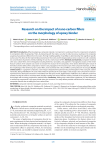
Research on the impact of nano carbon fillers on the morphology of epoxy binder
Статья научная
Introduction. When developing a composite material, it is important to understand how the components included in its composition affect its properties. Fillers, by interacting with the matrix, can alter its initial structure, resulting in the composite acquiring characteristics different from the matrix. The high modifying ability of nanofillers is determined by their significant specific surface area. This allows for the total interfacial area between the matrix and the dispersed phase to be covered even with a relatively low concentration of particles, thereby enabling the use of a small amount of filler. Methods and materials. Composite materials with nano carbon fillers were investigated, including fullerenes, nanotubes, and graphene. Fractographic analysis of the tensile fracture surfaces of the samples was chosen to evaluate the structure of the composites, which allows determining the nature of the failure and the ability of the composite to restrain crack propagation. The microstructure of the composite materials, as well as the morphology of the reinforcing nano carbon fillers, were examined with a Tescan MIRA3 scanning electron microscope. Results and discussion. In a graphene composite, crack energy is dissipated through branching and elongation of the crack path. Carbon nanotubes, being embedded in the crack walls, hinder the opening of the crack edges. Crack energy is also consumed in overcoming friction forces during the extraction of nanotubes from the epoxy matrix. Agglomerates of fullerenes act as effective crack front arresters, forcing the crack to circumvent them, thereby creating new areas of fracture surfaces. This leads to an increase in the crack front length and the energy required for material failure. Conclusion. Adding nano-carbon fillers (graphene, CNT and fullerenes) as reinforcing components in the epoxy binder alters the structure. The study defines possible mechanisms for hardening of the composite materials due to adding the nano-carbon fillers.
Бесплатно

Resource-saving nanotechnologies in waste water treatment
Статья научная
This paper examines the prospective field of nanotechnology development in the area of wastewater treatment and water processing. The introduction showed (no need for comma) that the Russian problem is not the lack of water – but its quality. Water treatment is needed to prevent water facilities from pollution. Self-cleaning methods cannot withstand the massive impact of pollutants, some of which are unknown for their natural reproduction processes. The degree of purification depends on the concentration of the pollution and the content of different substances within it. The use of nanotechnologies in effluent neutralization (EN) processes will allow removing insoluble sludges, wastes of chemical industry, and harmful microorganisms. Methods and materials. This work presently uses analytical methods to study nanotechnologies. Nanofiltration and membrane methods are frequently used in wastewater treatment. Methods such as arc charge, ablation, and gas-phase deposition are applied to obtain carbon nanotubes. Results. The authors describe promising carbon nanomaterials for production of membranes used in purification/decontamination/ desalination of water. The new generation of membranes for filtering, disinfection, and desalination have been shown. These include graphene and carbon nanotubes which present absolutely new nanomaterial. Discussion. It was revealed that such membranes are characterized not only by a high water percolation rate, but also by extraordinary selectivity. Such membranes are particularly promising in the field of biomedicine, as large membranes are necessary for the nanofiltration and desalination processes. Conclusions. This paper examines new ecological and resource-saving technologies making possible improved research, industrial and commercial activities (which by means of practical implementation of inventions will lead to improved products), technologies and organizational decisions. One of the most promising areas for the development of nanotechnologies applied in waste water treatment is the advancement of membrane technology employing innovative materials, specifically graphene and carbon nanotubes.
Бесплатно
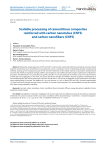
Статья научная
Utilizing the unique properties of CNTs and CNFs to enhance the mechanical and fracture properties of cement based materials and develop smart cementitious nanocomposites can be a challenge in terms of developing scalable manufacturing methods. Scaling up the manufacturing size of CNT and CNF reinforced cement based materials and produce multifunctional concrete that exhibits exceptional strength, stiffness and toughness and multifunctionality requires optimization of dispersion procedure. The effectiveness of successfully using CNTs and CNFs in concrete depends on the fiber count, the volume fraction of sand and coarse aggregates. In this work, we present the flexural strength and stiffness, fracture toughness and brittleness of nanomodified pastes and mortars reinforced at amount of 0.08 and 0.1 wt% and an investigation on the optimization of the fiber count proportioning of concrete. The addition of a very low amount, 0.1 wt%, of both CNTs and CNFs, increases approximately 1.5 times the flexural strength and the Young`s modulus of concrete nanocomposites. The nanomodified concrete also exhibits 60% higher energy absorption capability.
Бесплатно
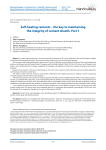
Self-healing cements – the key to maintaining the integrity of cement sheath. Part 1
Статья научная
To control water production, it is necessary to seal the channels of 20–25 mm thickness in the cement sheath at a depth of hundreds and thousands of meters. The most promising solution is the use of self-healing cements. The concept of self-healing materials has been known since the 1980s due to the studies of Donald Jud. The most fundamental works are by Sybrand van der Zwaag, Sheba D. Bergman and Fred Wudl, Richard P. Wool, D.Y Wu, N.R. Sottos, Erin B. Murphy, Henk Jonkers, who substantiated the concept, suggested technologies and additives to restore the integrity of polymer and cement materials. Despite active research in this area, Schlumberger is the only service company which elaborated and successfully applied the «self-healing» well cement called Futur. The authors of the article set the task of well cement modification that enables autonomous «healing» of water-conducting channels through which formation water migrates. The following materials were used in the study: polyacrylamide (PAA), water-swellable polymer (VNP V-615), sodium polyacrylate (SP), cross-linked PAA copolymers, active waterproofing mineral additives and swelling elastomers. Most of the additives have a degree of swelling of more than 150%, they effectively reduce a permeability of the cement stone, however multi-layer coating is required to control the speed of their swelling. A significant drawback of the analyzed materials was the complexity of the coating. A cross-linked AA copolymer based on anionic polycrylamide was the most effective reagent, which was easy to cover with a water-soluble shell. The cement stone with integrated agent of AA copolymer demonstrated a permeability of 0.0018 μm2 with the strength of the samples for bending at the age of 2 days equal to 8.0 MPa.
Бесплатно

Self-healing cements – the key to maintaining the integrity of cement sheath. Part 2
Статья научная
To control water production, it is necessary to seal the channels of 20–25 mm thickness in the cement sheath at a depth of hundreds and thousands of meters. The most promising solution is the use of self-healing cements. The concept of self-healing materials has been known since the 1980s due to the studies of Donald Jud. The most fundamental works are by Sybrand van der Zwaag, Sheba D. Bergman and Fred Wudl, Richard P. Wool, D.Y Wu, N.R. Sottos, Erin B. Murphy, Henk Jonkers, who substantiated the concept, suggested technologies and additives to restore the integrity of polymer and cement materials. Despite active research in this area, Schlumberger is the only service company which elaborated and successfully applied the «self-healing» well cement called Futur. The authors of the article set the task of well cement modification that could enable autonomous «healing» of water-conducting channels through which formation water migrates. The following materials were used in the study: polyacrylamide (PAA), water-swellable polymer (VNP V-615), sodium polyacrylate (SP), cross-linked PAA copolymers, active waterproofing mineral additives and swelling elastomers. Most of the additives have a degree of swelling of more than 150%, they effectively reduce a permeability of the cement stone, however multi-layer coating is required to control the speed of their swelling. A significant drawback of the analyzed materials was the complexity of the coating. A cross-linked AA copolymer based on anionic polycrylamide was the most effective reagent that was easily covered with a water-soluble shell. The cement stone with integrated agent of AA copolymer demonstrated a permeability of 0.0018 μm2 with the strength of the samples for bending at the age of 2 days equal to 8.0 MPa.
Бесплатно
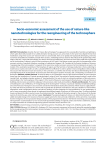
Статья научная
Introduction. Recently, the term “nature-like technologies” has appeared in the everyday life of scientists and politicians, which quite deservedly include the so-called alternative energy sources (sun, wind, heat). At the same time, despite the fact that installations using these sources are “seasonal” and low concentrated, their use is rapidly and haphazardly developing, and many economists and politicians mistakenly consider them as basics, misleading business. Based on the analysis of the epistemology of the origin of the term "nature-like technologies", this article shows the groundlessness, and even the harm of the rapid and unsystematic use of wind turbines. Evidence is given of the inconsistency of the "myths" that Nature cannot cope with the compensation of the economic activity of mankind, therefore, according to Academician Sergeyev S.M., President of the Russian Academy of Sciences, "reengineering of the technosphere" is required. At the same time, modern economic science is far from taking into account in his models of the assimilation potentials of the biosphere of regions and the functions of entropy production in them, preferring to model various “cycles and modes”, as well as calculate different “coefficients” in order to predict “crises and equilibria”, without taking into account the interaction nature and society. In this connection, a scientific and technical task about determinating the “place of reengineering of the technosphere” in the structure of the life support systems of society, and, consequently, to evaluate its effectiveness. Methods, models and tools. To solve the tasks set, it is proposed to use the “retro-forecast method” of socio-economic losses from the introduction of “natural nanotechnologies”, using as “tools” the method of “spatio-temporal analysis”, model of the Leontief-Ford and adaptive taxation systems of “harm production”, the use of which in solving the problems of fire and environmental safety in the "technospheres of the regions" of the South of Russia (in road transport infrastructures, in cities and towns, in buildings and structures), proved their adequacy to the processes under study and usefulness. Results and discussion. The results of modeling the costs of efficiency of "reengineering of the technosphere" in Russia, in particular individual residential buildings, and a retro-forecast of changes in socio-economic and environmental losses during the autonomy of their resource supply (electricity, water and heat) are presented. It is shown that the production of domestic innovations in this area (“Shukhov’s” wind turbines, atmospheric water condensation devices and electric heating) will allow stopping the “total gasification” of rural settlements, as well as more economically than abroad, to implement decentralized supply of resources in Russia more than 10 million individual houses and about 40 million country houses, thus determining the “true place of alternative energy” in the structure of the Russian systems of electricity, gas, water and heat supply. Conclusion. The proposed approach allows us to determine the place of the socalled renewable energy in the structure of resource supply systems for cities and rural settlements. At the same time, it is possible that the emergence of more productive design solutions of the proposed innovations in the field of wind energy and solar panels will expand the "autonomization" to low-rise and multi-apartment buildings in regional centers and workers' settlements, instead of a major restoration of centralized engineering systems with boiler houses and mini- CHP.
Бесплатно
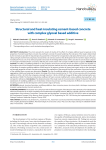
Structural and heat-insulating cement-based concrete with complex glyoxal based additive
Статья научная
Introduction. The article presents the results of studies of the effect of complex additive based on glyoxal on the properties of cement-based foam concrete mix and foam concrete of natural hardening. The relevance of the study is determined by the necessity to provide the required process parameters of mixture for transportation and laying the formwork, as well as providing strength and thermal and physical characteristics of wall structures for the development of the northern regions of Russia, including the Arctic zone. It has been proposed to decrease the shrinkage deformations of the concrete mix and increase compressive strength of hardened foam concrete by affecting the cement matrix with complex modifier based on glyoxal. Materials and methods. The effect of modifying additives on the properties of the foam concrete mixture and foam concrete was studied at a W/S mixture ratio of 0.45. Research has been carried out using test methods set out in national standards. The results of the study of the effect of complex modifying additives (CMA) based on an aqueous solution of glyoxal and organic acids on the rheological and strength properties of foam concrete are presented, the regularities of the processes and the mechanism of structure formation of the modified foam concrete are determined. Results. The use of modifying additives leads to increase result in increasing the aggregative stability and reducing the plastic shrinkage of the foam concrete mix by 22–70%. In foam concrete with the complex additive LA 0.5% + Gl 0.55% the compressive strength rises from 1.96 to 2.43 MPa at the age of 28 days while maintaining the average density of D600. The thermal conductivity coefficient of foam concrete modified with various additives decreased by 5–30% compared to references. Conclusions. The obtained results of the study create in the construction industry the basis for the import substitution of modifying additives on the domestic mineral resource base and the production of effective structural and heatinsulating concretes for the development of the northern regions of Russia.
Бесплатно
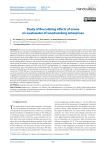
Study of flocculating effects of ozone on wastewater of woodworking enterprises
Статья научная
The sewer of woodworking enterprises in the construction industry are characterized by a high content of suspended and dissolved toxic substances, including phenol, and a high value of chemical oxygen consumption (COD). At the same time, some enterprises do not have their own local treatment facilities and need to develop their own integrated treatment systems. One of the effective methods for removing pollution is wastewater ozonation, used in three versions: flocculation with small doses of ozone (pre-ozonation) at the initial stage to remove suspended substances, oxidative ozonation and decontamination. However, methods for treating wastewater from wood processing plants using ozone have not been sufficiently studied. Therefore, we investigated the flocculating effect of ozone in the process of cleaning the effluents of the plywood-plate mill, tested the effect of the dose of ozone during flocculation in the presence of a small number of coagulants VPK-402 and Kaustamine-15 on the concentration of suspended substances, phenol and COD value. VPK-402 and Kaustamine-15 – reagents of regional production, are low-toxic and are allowed for use in the treatment of even drinking water. The results of the experiments on the pre-ozonation of wastewater showed a high efficiency of this method, which allows reducing COD by 3.8 (VPK-402) and 2.3 times (Kaustamine-15), phenol content by 2.9 (VPK-402) and 1.9 times (Kaustamine-15), suspended content by 4.0 (ВПК-402) and 3.5 times (Kaustamine-15). The use of pre-ozonation makes it possible to completely abandon flocculants in the physicochemical stage of wastewater treatment. Coagulation-flocculation can be successfully carried out with ozone and coagulant in small doses of 2–5 and 40 mg/dm3 (VPK-402) or 50 mg/dm3 (Kaustamine-15), respectively, for 5 minutes. Physicochemical indicators of water quality improved compared to treatment with coagulant alone: COD decreased by 23%, phenol content by 55%, suspended substances by 22%. The use of ozone as a flocculant in the clarification of wastewater reduces the cost of reagents, prevents secondary contamination of water, and increases the efficiency of further oxidative treatment.
Бесплатно
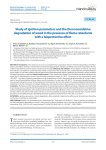
Статья научная
Introduction. This study aims to carry out comprehensive comparative research of thermal degradation and inflammation parameters of timber covered with fire resistant biological flame retardants of different chemical composition. We also looked at the efficiency and the action mechanism of the latter. Materials and methods. As the objects of research, the means were selected – phosphorase-containing water-soluble compounds of the nanoscale series, complex biocides and special bioplasticizers (Agent 1) and water-soluble nanoscale diammonium hydrophosphate (Agent 2) applied to pine wood by surface treatment and deep impregnation methods. Results and discussion. Thermogravimetric studies of wood treated with flame retardants have shown that its decomposition occurs in the following temperature ranges: 30–150°C – the process of loss of moisture by wood; 150–400°C – the effect of protective mechanisms of the compositions, as well as the process of decomposition of the main components of wood (hemicellulose, cellulose, lignin) and the formation of a coke layer; 400–800°C – the process of gradual burnout of the coke layer taking into account its thermophysical characteristics up to the ash residue. It has been established that both flame retardants act by the mechanism of catalytic dehydration and reduce the rate of decomposition of wood from 29 to 10%/min. Conclusion. The features of the thermal decomposition of wood protected by two different chemical composition and method of its processing means are determined. The parameters of the flammability of pine wood treated with fire-protective compounds by surface and deep impregnation were obtained, which indicate their high efficiency, which is confirmed by the values of the coke residue at 400°C, the nature of DTG peaks and DSC curves. The possibility of using the obtained materials from wood for interior decoration and cladding of facades of buildings that meet regulatory requirements for their safe use is shown.
Бесплатно
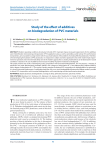
Study of the effect of additives on biodegradation of PVC materials
Статья научная
Modern operating conditions of polyvinyl chloride (PVC) materials impose increased requirements for the additives used. Intensification of processing and expansion of PVC application areas, as well as providing a wide variety of its performance characteristics, are associated to a large extent with the successful solution of the problem of creating effective plasticizers. Therefore, when developing formulations of PVC plasticates, it is important to obtain and select plasticizers that meet modern high requirements for operation and environmental safety. One of the modern approaches to creating materials that can be destroyed in natural conditions is based on the use of additives that increase the ability of polymer materials to biodegrade. This paper presents the results of developing a PVC composition with increased biodegradation. For this purpose, a mixture of plasticizers was used: dibutoxyethyl phthalate (DBOEP) with a degree of ethoxylation of 1.5 and dibutoxyethyl adipate (DBOEA) with a degree of ethoxylation of 1.5. The results of testing samples of obtained PVC compositions for biodegradation are presented. It is shown that partial replacement of a phthalate plasticizer with a non-toxic biodegradable dibutoxyethyl adipate makes it possible to obtain PVC compositions with increased biodegradation, while maintaining excellent performance properties.
Бесплатно
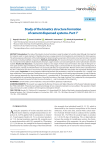
Study of the kinetics structure formation of cement dispersed systems. Part I
Статья научная
Introduction. The study of the kinetics structure formation is rarely the subject of a careful study. Although it is important for materials used to create elements of building structures, energy elements, thermoelements and materials for other purposes. The article proposes refinements of the methodology for determining the parameters of the kinetics structure formation of cement composites, including modified compositions. Methods and materials. The structure formation of cement systems with plasticizers, microsized mineral additives (hydrosilicates of barium, copper and zinc) and nanosized particles of zinc hydrosilicates has been studied. Results and discussion. It is proposed to single out two stages of initial structure formation: the stage of setting the cement paste and the stage of hardening. The selection of the setting stage is connected with the natural laws of the development of natural systems, namely, the initial formation of a structural grid obeys an exponential law. Moment of time when a deviation from this law is observed is the time of occurrence of spatial and/or prescription difficulties that hinder the exponential development of the system. Conclusions. A strong negative relationship between the parameters φ and β of the equation H(t) = a exp(φt β) has been established. These parameters characterize the rate of structure formation at the setting stage (parameter φ) and the density of the structure (parameter β or the internal dimension Di, 0 associated with it). The presence of such a negative relationship indicates the inadvisability of accelerating the processes of structure formation at the stage of setting. This is supported by a strong positive relationship between the period of initial structure formation t0, s1 and the strength of the material R28.
Бесплатно
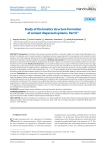
Study of the kinetics structure formation of cement dispersed systems. Part II
Статья научная
Introduction. The study of the kinetics structure formation is rarely the subject of a careful study. Although it is important for materials used to create elements of building structures, energy elements, thermoelements and materials for other purposes. The article proposes refinements of the methodology for determining the parameters of the kinetics structure formation of cement composites, including modified compositions. Methods and materials. The structure formation of cement systems with plasticizers, microsized mineral additives (hydrosilicates of barium, copper, iron and zinc) and nanosized particles of zinc hydrosilicates has been studied. Results and discussion. It is proposed to single out two stages of initial structure formation: the stage of setting the cement paste and the stage of hardening. It was found that the strength of the material at the stage of hardening should be influenced by an additional factor, depending on the type of the introduced substance. A strong negative relationship between the parameters α and n of the equation R(t) = Rmax(1–eatn) at the hardening stage was confirmed. The trends identified at the setting stage also demonstrated, namely: an increase in the rate of structure formation leading to the formation of a less dense structure. Conclusions. An analysis of the change in the value of the internal dimension of the system during the transition from the stage of setting to the stage of hardening made it possible to identify two trajectories of the system development. The first trajectory appears only by combining the elements of the structure (trajectory No. 1). Preservation of the characteristic dimensions of structural elements, but an increase in the proportion of elements with small dimensions (when the conditions that prevent the combination of elements of the structure are realized) describes the second trajectory (trajectory No. 2). The implementation of trajectory No. 2 is typical for compositions which the structure formation of cement stone is carried out in the presence of Melment F15G plasticizer or microsized particles of copper or zinc. For other studied compositions, structure formation is proceeding with the enlargement of structural elements.
Бесплатно
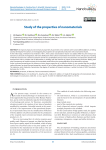
Study of the properties of nanomaterials
Статья научная
To improve physical and mechanical properties of pavements new materials with nanomodified additives are being actively developed. The authors are investigating the properties of road petroleum bitumen with nanomaterial Taunit. At the initial stage, oil bitumen was heated to 100о C. Then carbon nanomaterial «Taunit» was added. After that, the mixture was stirred in an ultrasonic homogenizer until even distribution of the carbon nanomaterial in the total volume. The process of cooling of the final structure was carried out until the end of the crystallization process. Then, the specimens are exposed to tension and strength tests with a constant rate of deformation or loading until the moment of rupture on the testing machines. Mixing with other components of asphalt concrete in the standard mode follows the nanomodification of the bituminous mixture. Under increased temperatures the bitumen mixture keeps properties of an effective binder. It was revealed that the modified carbon bitumen has good thermal properties, namely, it has a higher softening temperature (Δt is in the range from 6 to 10ºС). The indicator, which indirectly characterizes the degree of hardness of bitumen solutions, is within the limits of GOST standards, decreases by 15–20%.
Бесплатно
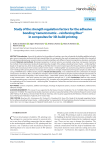
Статья научная
Introduction. As part of the solution for the problem of creating a new class of materials for building additive technologies, cement composites reinforced with high-strength fiber, this work presents the results of experimental studies of the strength of the adhesive bonding between cement matrices and reinforcing fibers with different chemical compositions, diameters, and tensile strength. Materials and methods. Rheological properties of cement systems were studied using shear and squeeze rheometry, the method of micromechanical testing for determining the strength of the adhesive bonding “cement matrix – reinforcing fiber” based on the pull-out test, which involves pulling out the fiber from the cement matrix layer; after the pull-out test for all the studied systems, the microstructure of the contact surface “cement matrix – reinforcing fiber” was assessed using a Thermo Scientific™ Phenom ™ Desktop SEM scanning electron microscope; the compressive strength of hardened cement paste-samples was determined using an INSTRON Sates 1500HDS testing machine. Results and discussions. It was established that the combination of strength characteristics of matrices, fibers, and adhesive strength at their interface allowed securing the required strength characteristics of reinforced construction composites. In the “cement matrix – carbon fiber” systems, the value of adhesive strength was 9 – 11 MPa; in the “cement matrix – steel wire” systems, the value of adhesive strength was 3 – 4 MPa. Conclusions. Matrices with viscosity modifiers containing nano- and micro-sized particles of SiO2 (complex nano-sized additive and metakaolin) are reasonable options for combinations of the “cement matrix – reinforcing fiber” components. Carbon fiber and steel wire are recommended to be used as reinforcing fibers.
Бесплатно
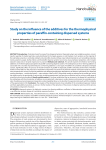
Статья научная
Introduction. Particular interest for research has dispersed systems. Dispersed systems are multiphase systems, consisting of a quantity of smallest particles, evenly distributed in the liquid, gaseous or solid medium. Such systems are the majority of the real bodies around us: soil, bodies of plant and animal life, clouds and fogs, many industrial products, such as building materials, metals, polymers, paper, leather, fabrics and foodstuffs. Disperse systems have many unusual physical properties, which require separate study and are of great importance in practice. Methods and materials. This article explores the influence ion-forming additives on the thermophysical properties of paraffin-containing disperse systems. The widespread use of ion-forming additives is associated with a number of positive features. Ion-forming additives is a new type of modifiers of crystalline solid phase and liquid crystals, significantly affect the process of micelle formation of paraffin in dispersed paraffin-containing environment. Therefore, studies on their effect on the processes of nucleation and growth of crystals are of particular interest. During the research, samples were prepared with various ion-forming additives and obtained temperature dependences of dielectric permittivity for dispersed systems petrolatum – methyl ethyl ketone – water solution of NaCl and KCl. Polynomial models are selected as the model type, which are widely used in the processing of various data, including experimental, and are also an effective tool for solving a wide range of scientific and technical problems. Results and discussion. It has been established that an increase in the degree of crystallinity of the solid phase with the introduction of additives is associated with a decrease in surface tension and increase in secondary nucleation. Resulting universal regression dependence of permeability allows us to describe the experimental results with the reliability of the approximation 0.99. Conclusion. The analysis of the obtained results shows reliability of the considered regression models and their applicability in practice, as well as in further studies of the dynamics of the process in disperse systems and the process of nucleation and growth of crystals.
Бесплатно
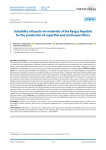
Статья научная
Introduction. Literature analysis and patent search revealed that basalt rock and its fibers have exceptional physical and technical characteristics and alongside abundant raw material reserves. Based on this, the use of basalt rocks and their fibers as a material for the development of advance composite materials with high performance characteristics is a promising direction. Diverse technological fields and economic sectors, as well as various material requirements, necessitate a spectrum of systems, compositions, and properties for basalt and its melts, whether for generating superthin or continuous fibers. Methods and materials. The chemical and mineralogical compositions of some basalt rocks from deposits in the Kyrgyz Republic were studied to determine their suitability for production of superthin fibers and continuous fibers. The acidity modulus and fusibility modulus were determined by calculation based on the chemical composition of basalts of the Kyrgyz Republic. Among them, the quality of basalts from the Suluu-Terek deposit and basalts from the Toru-Aigyr deposit fully meets the requirements for the quality of raw materials for creating the production of basalt superthin fibers (BSF) and basalt continuous fibers (CBF). In the research we used physical and chemical analysis methods to determine the chemical and mineralogical composition of basalt. By calculating the acidity and fusibility modulus of basalt raw materials from the Kyrgyz Republic, as well as comparing them with relevant standards, their suitability for the production of basalt superthin fiber (BSF) and basalt continuous fiber (CBF) was established. The object of the study was the basalts of the Sulu-Terek deposit. Results of the study include an analysis of the chemical and mineralogical compositions of certain basalt rocks from deposits in the Kyrgyz Republic in order to assess their suitability for the production of superthin and continuous fibers. The acidity modulus and fusibility modulus of basalts of the Kyrgyz Republic were determined by the calculation method. Among them, it was revealed that the quality of basalts from the Suluu-Terek deposit and basalts from the Toru-Aigyr deposit fully meets the requirements for the quality of raw materials for the production of basalt superthin fibers (BSF) and basalt continuous fibers (CBF). Conclusion. The suitability of basalt rocks from various deposits, especially Suluu-Terek, Taldy-Bulak and Kashka-Suu, was confirmed, with recommendations for use. The results also highlight the importance of compliance with standards when selecting deposits and setting production parameters.
Бесплатно
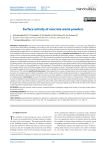
Surface activity of concrete waste powders
Статья научная
Introduction. One of the most large-tonnage wastes of the construction industry is a concrete scrap, obtained as a result of the dismantling of buildings and structures, the service life of which has reached its maximum or requires significant capital changes. In our opinion, works on the use of the resulting dust-like fraction are of particular interest. One of the promising methodological approaches in this direction is the observance of the principles of nanotechnology, which consists of obtaining finely dispersed components as active components of the created compositions. Materials and methods. Therefore, the objects of research in this work were fine powders obtained by mechanical grinding of lightweight (sample 1) and heavy (sample 2) concrete of a five-story residential panel house built in 1979. The elemental composition and specific surface area of the samples were determined, thermogravimetry of the studied powder systems was carried out, the surface tension of the experimental samples and the dispersion and polarization components of this indicator were determined by the OVRK method. A new methodological approach to the determination of the surface tension of powder systems is proposed, based on the determination of the functional dependence of the surface tension on the pressing force of the prototypes. The possibility of calculating macroenergy characteristics (atomization energy, specific mass atomization energy) of waste concrete samples is shown. These physicochemical indicators characterize the potential supply of internal energy of the system, which is capable of transforming into free surface energy during mechanical destruction of the material. Results and discussions. Thermogravimetric analysis of experimental concrete samples showed the presence of a residual amount of belite. Calculations of the surface activity of the samples showed that it is more preferable to use a powder obtained by crushing a sample of heavy concrete as an active additive in compositions capable of exhibiting the properties of a binding agent. Conclusions. To assess the activity of dusty fractions of concrete scrap as a component in binding compositions of the hydration type of hardening, it is proposed to use the value of the surface activity of powder systems as a criterion. The absolute numeric value of this criterion is equal to the ratio of the values of the free surface energy of the investigated powder and the specific mass energy of atomization of the initial waste concrete. It was found that for concrete waste the value of this criterion is determined by the polarization component of surface tension.
Бесплатно
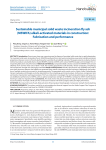
Статья научная
Introduction. Recent years have seen a pressing need to dispose of municipal solid waste due to rapid urbanization. The municipal solid waste incineration fly ash (MSWIFA) produced from solid waste incineration power plant exhibits pozzolanic properties and poses concern of toxicity leaching when used directly as building materials. This paper presents an alkali-activation method to produce sustainable alkali-activated MSWIFA materials (AAFMs) with various MSWIFA dosages and investigate the corresponding fabrication and performance. Materials and Methods. Composited alkali activators activate the MSWIFA with constant alkalinity of 5% and the molar ratio of Si/Na = 0.86. The resulting geopolymers' bulk densities, mineral composites, morphology, and compression strength are thoroughly examined. Results and discussions. Results show that the use of MSWIFA may lead to more loose structures because the bubbles are generated from metallic aluminum and alkali activators. Additionally, the production of multiple crystals also accounts for increasing porosity. The generated multi-crystals such as Sylvite, Halite, Hydrocalumite, Calcium Hydroxide, and Ettringite are further detected from the morphology and mineral analysis. Furthermore, compression tests and toxicity characteristic leaching procedures (TCLP) are conducted to investigate the mechanical performance and heavy metals solidification performance of AAFMs, with an optimal compression strength of 19.99MPa at 28 days for AAFM-10 while toxicity leaching is subject to regularity limits. Conclusions. This study shows that great potential of using the alkali-activation method to recycle hazardous municipal solid fly ash into construction materials with both ecological safety and high performance.
Бесплатно
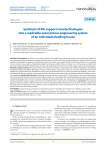
Статья научная
Introduction. Currently, one can witness a boom of renewable energy in foreign countries: zones with earth, coastal and even offshore wind power plants are emerging, and the roofs of houses, hotels, schools and hospitals are being "dressed" by solar batteries and by panels to generate electricity and water. At the same time, despite the fact that these installations are unreliable and rare sources, many experts and politicians begin to mistakenly consider them as the basic ones. All that poses a scientific and technical problem of determining the place of nature-like technologies in the structure of life support systems of the population. Methods, models and tools. The paper analyzes the engineering systems of multi-apartment residential buildings and individual residential buildings that deliver life support resources (electricity, gas, cold and hot water, etc.). But one should also note that the engineering systems often keep potential fire-energy and environmental harm. To resolve the mentioned problems, some nanotechnologies and Russian patents concerning autonomous electricity, water, heat supply of individual residential buildings on them were proposed. Results and discussion. Modeling has shown that the combination of "Shukhovskaya" and vortex wind turbines with domestic hydraulic panels and solar panels makes it possible to create duplicated and tripled engineering systems of individual residential buildings, which, in terms of quality, reliability and safety parameters, are several orders of magnitude higher than the existing centralized resource supply systems for the residential sector of cities and rural settlements. Conclusion. The proposed approach makes it possible to determine the place of the so-called renewable energy in the structure of the resource supply system for cities and rural settlements, and it remains to assess its effectiveness, which is supposed to be done using the Leontiev-Ford model and the retro-forecasting method.
Бесплатно

